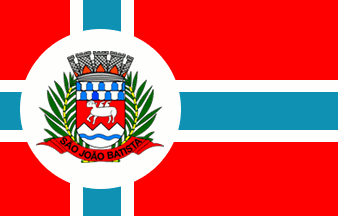 image by Dirk Schönberger,
7 August 2012
image by Dirk Schönberger,
7 August 2012
Last modified: 2021-12-11 by ian macdonald
Keywords: santa catarina | são joão batista |
Links: FOTW homepage |
search |
disclaimer and copyright |
write us |
mirrors
 image by Dirk Schönberger,
7 August 2012
image by Dirk Schönberger,
7 August 2012
The municipality of São João Batista (37,424 inhabitants in 2019; 22,073 ha)
is located 70 km west of Florianópolis.
São João Batista originates in
the parish of São João de Alto Tijucas, established by Law No. 90 promulgated on
19 April 1838. The founder was Captain João de Amorim Pereira (d. 1860),
administrator of the Nova Itália colony. Italian colonization of the parish was
allowed by Law No. 49 promulgated on 15 June 1836. São João de Alto Tijucas was
incorporated on 13 June 1860 to the newly formed municipality of Tijucas.
The
municipality of São João Batista was established by State Law No. 348
promulgated on 21 June 1958 and inaugurated on 19 July 1958.
São João
Batista is Brazil's 4th shoe-making center. The number of shoe-making companies
increased from 20 in the 1960s to 300 in 1986 and 395 now, employing 10,000
workers. São João Batista was proclaimed Santa Catarina's Capital of Shoe-making
by State Law No. 12,076 promulgated on 27 December 2001.
https://www.sjbatista.sc.gov.br/
Municipal website
Ivan Sache, 7 November 2021
An off-centred blue cross, bordered white, on a red field, with the municipal shield in a white disk on the cross.
Official website at
http://www.sjbatista.sc.gov.br
Dirk Schönberger,
7 August 2012
The flag and arms of São João Batista are prescribed by Municipal Law No.
637 promulgated on 9 September 1980.
Article 6.
The municipal flag of
São João Batista, designed by the heraldist and vexillologist Lauro Ribeiro
Escobar, is: Rectangular, red with a blue cross bordered in blue, on its arms'
intersection, a white circle charged with the coat of arms described in Article
19.
Article 7.
In compliance with heraldic rules, the municipal flag
shall have the official dimensions prescribed for the national flag, 14 units
in width on 20 units in length.
Article 19.
The coat of arms of the
municipality of São João Batista, designed by the heraldist and vexillologist
Lauro Ribeiro Escobar, is: Iberian shield. Gules a Paschal lamb argent a chief
vert a base serrated argent a fess wavy azure. The shield surmounted by a mural
crown argent with eight towers ports gules. The shield supported dexter and
sinister by sugarcanes proper. A scroll gules inscribed with the toponym "São
João Batista" surrounded by date "19/07/1942" argent.
The coat of arms
shall have the following interpretation
a) The Iberian shield was used in
Portugal at the time of discovery of Brazil; its adoption evokes the early
colonizers and builders of the homeland.
b) Gules (red) has for heraldic
meaning audacity, courage, value, gallantry, intrepidity, nobleness, generosity
and honor, alluding to the attributes of the early colonizers of the region,
inherited by their successors, who courageously believed in the vigor of the
land, settled there and built a prosperous municipality.
c) The Paschal lamb
is the attribute of St. John the Baptist, evoking the patron saint to which the
parish church was dedicated, and making the arms canting.
d) The chief vair
represents shoe-making industry, which makes of São João Batista Santa
Catarina's Capital of Shoe-making. In heraldry, vair is used as a symbol of
high nobleness, preeminence and notable dignity. It is therefore used to
represent production of leather of high quality.
e) The base serrated
represents the hilly topography of the municipality, while the fess wavy
represents its hydrographical resources, especially river Tijucas, whose banks
are the site of São João Batista.
f) Argent is a symbol of felicity, purity,
temperance, truth, frankness, beauty, integrity and friendship. Azure (blue) is
a symbol of justice, beauty, nobleness, incorruptible firmness, glory, virtue,
constancy, dignity, zeal and loyalty, highlighting the attributes of the
administration and of the citizens and the atmosphere of harmony and compromise
among São João Batista's people.
g) The mural crown is a symbol of political
emancipation; argent, with eight towers, five of them visible, it is the proper
attribute of a town. The open gates proclaim the people's hospitality. Gules
(red) in the municipal crown indicates in Brazil law and justice, meaning that
São João Batista is the seat of a county and "between these gates stands
justice".
h) The sugarcanes highlight an important source of income, São
João Batista being known as Santa Catarina's Capital of Sugar.
i) The scroll
is inscribed with the toponym and "19/01/1942", the date of solemn inauguration
of the municipality.
https://leismunicipais.com.br/a/sc/s/sao-joao-batista/lei-ordinaria/1980/64/637/lei-ordinaria-n-637-1980-dispoe-sobre-a-forma-a-apresentacao-dos-simbolos-do-municipio-de-sao-joao-batista-e-da-outras-providencias
Leis Municipais database
Photos
https://omunicipio.com.br/tcesc-aponta-desvios-de-receitas-do-ipva-na-prefeitura-de-sao-joao-batista/
https://www.facebook.com/prefeiturasjb/photos/4179410895445350
https://www.facebook.com/camaradevereadoressjb/photos/2716329985162862
The first flag of São João Batista was prescribed by Municipal Law No. 131
promulgated on 30 November 1967.
Article 2.
The flag shall have the
following colors.
a) White
b) Red
c) Yellow
d) Green
e) Black.
https://leismunicipais.com.br/a/sc/s/sao-joao-batista/lei-ordinaria/1967/14/131/lei-ordinaria-n-131-1967-cria-a-bandeira-do-municipio-de-sao-joao-batista
Leis Municipais database
The first coat of arms of São João Batista
was prescribed by Municipal Law No. 130 promulgated on 30 November 1967.
Nothing is said about its design.
https://leismunicipais.com.br/a/sc/s/sao-joao-batista/lei-ordinaria/1967/13/130/lei-ordinaria-n-130-1967-cria-o-brasao-do-municipio-de-sao-joao-batista
Leis Municipais database
Ivan Sache, 7 November 2021